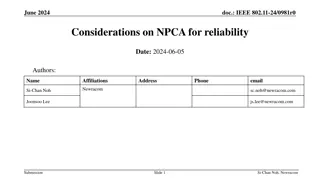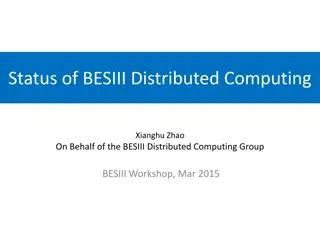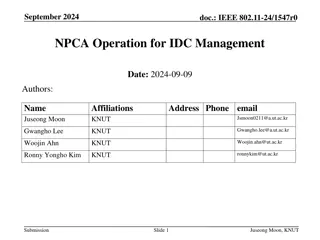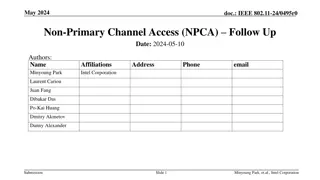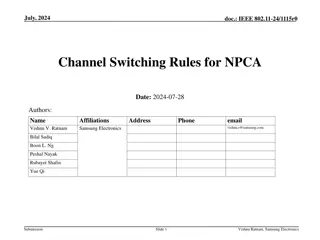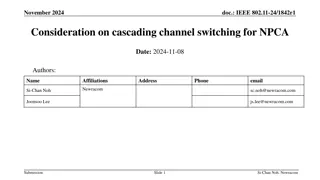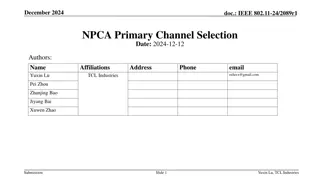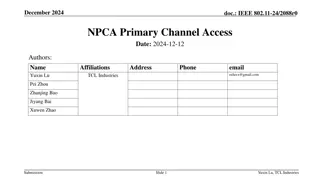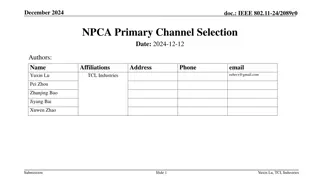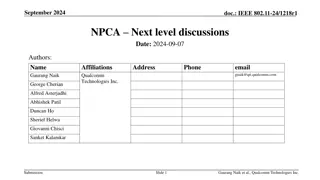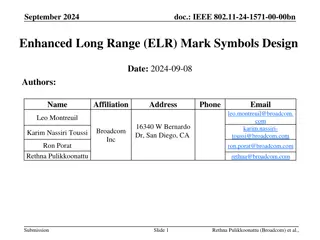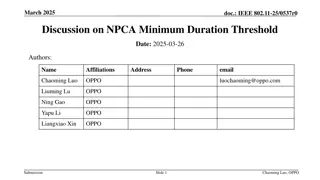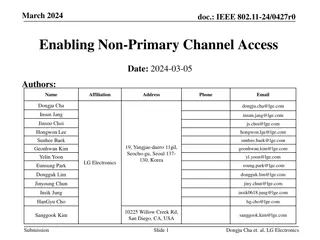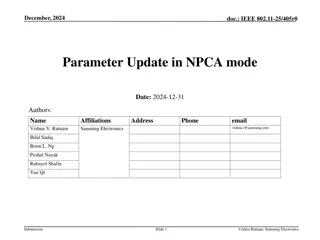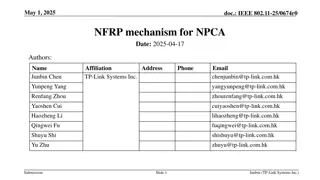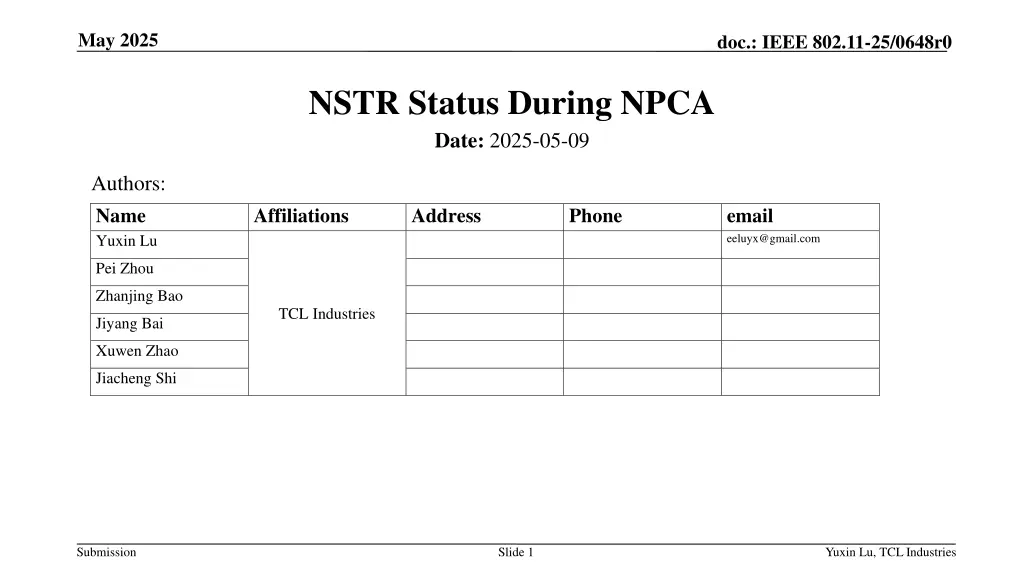
IEEE 802.11-25/0648r0 NSTR Update During NPCA Operation
"Learn about the proposed solution for updating NSTR status during NPCA operation in IEEE 802.11-25/0648r0 documentation. Addressing issues related to NSTR status changes and their impact on transmission efficiency during channel switching."
Download Presentation

Please find below an Image/Link to download the presentation.
The content on the website is provided AS IS for your information and personal use only. It may not be sold, licensed, or shared on other websites without obtaining consent from the author. If you encounter any issues during the download, it is possible that the publisher has removed the file from their server.
You are allowed to download the files provided on this website for personal or commercial use, subject to the condition that they are used lawfully. All files are the property of their respective owners.
The content on the website is provided AS IS for your information and personal use only. It may not be sold, licensed, or shared on other websites without obtaining consent from the author.
E N D
Presentation Transcript
May 2025 doc.: IEEE 802.11-25/0648r0 NSTR Status During NPCA Date: 2025-05-09 Authors: Name Yuxin Lu Affiliations Address Phone email eeluyx@gmail.com Pei Zhou Zhanjing Bao TCL Industries Jiyang Bai Xuwen Zhao Jiacheng Shi Submission Slide 1 Yuxin Lu, TCL Industries
May 2025 doc.: IEEE 802.11-25/0648r0 Background In current baseline operation, a non-AP MLD can signal its STR/NSTR capability for each pair of links during multi-link setup [1] Through NSTR Indication Bitmap field Some transmission behavior/limitation needs to be followed if a link pair is signaled as NSTR to achieve so-called simultaneously transmit In this proposal, we discuss NSTR status update procedure during NPCA operation Submission Slide 2 Yuxin Lu, TCL Industries
May 2025 doc.: IEEE 802.11-25/0648r0 Motivation According to passed motions [2], while the primary channel is known to be busy due to OBSS traffic, AP and STAs associated with the AP may switch to the NPCA primary channel and initiate transmission on the NPCA primary channel However, the NSTR status may change during NPCA operation duration due to channel switching, and this issue has not been addressed yet If link1 operates on 5 GHz, link 2 operates on 2.4 GHz, they are STR link pair regardless of NPCA channel switching If neither of the two links works on 2.4 GHz, their NSTR status may very likely change (see Table below) NSTR status before switching Effect caused by switching NSTR status after switching Frequency separation decreased; NSTR link status changed STR Frequency separation decreased/increased; STR link status unchanged Frequency separation increased; STR link status changed NSTR Frequency separation decreased/increased; NSTR link status unchanged Submission Slide 3 Yuxin Lu, TCL Industries
May 2025 doc.: IEEE 802.11-25/0648r0 Motivation If non-AP MLD does not report its NSTR status during NPCA to the AP MLD, following issue may occur NSTR status before switching NSTR status after switching Effect if not updated AP MLD is unaware of such change, does not follow NSTR transmission STR NSTR limitations, transmission may fail or interfere with the other link AP MLD is unaware of such change, still applies NSTR transmission NSTR STR limitations such as PPDU end time alignment on an NSTR link pair, which is not so efficient Submission Slide 4 Yuxin Lu, TCL Industries
May 2025 doc.: IEEE 802.11-25/0648r0 Proposed Solution Option 1: Indicate NSTR status (update) in NPCA ICR/ICF If non-AP STA can transmit ICR/ICF, it can include such NSTR status in ICR/ICF, then AP MLD apply the new STR/NSTR status during current NPCA operation Dynamic Option 2: Indicate NSTR status (update) in NPCA Capabilities Assume the location of NPCA primary channel is known by non-AP, it can signal such NSTR status as a type of capability Semi-static Option 3: Follow some access rules, for example, Non-AP do not perform NPCA switching or do not reply ICR if current NPCA txrx may interfere with the txrx of other links AP follows NSTR transmission behavior when transmitting NPCA ICF if it expects current txrx may interfere with the txrx of other links of the non-AP MLD Submission Slide 5 Yuxin Lu, TCL Industries
May 2025 doc.: IEEE 802.11-25/0648r0 Further Discussions Q: Other scenarios? A: Such issue also exists in DSO operation and NPCA+DSO operation, especially when two links are performing NPCA/DSO, which may very likely happen considering we are developing these two important features Q: Why not use Multi-Link Operation Update Request frame? A: Multi-Link Operation Update Request frame is used for long-term update, not suitable for temporary NSTR status update only during NPCA duration Q: Why not rely on the Frequency Separation for STR parameter? A: This parameter is only used as a reference value, and it may have no value A non-AP MLD may set the Frequency Separation For STR subfield in the Common Info field of the Basic Multi-Link element to a nonzero value if it intends to indicate the minimum frequency separation that is recommended between two links for the non-AP MLD for STR operation; otherwise, the non-AP MLD shall set the Frequency Separation For STR subfield to 0. [1] Submission Slide 6 Yuxin Lu, TCL Industries
May 2025 doc.: IEEE 802.11-25/0648r0 Conclusion In this contribution, we discussed the NSTR status change issue caused by channel switching from primary channel to NPCA primary channel and proposed corresponding solutions Option 1: Indicate NSTR status (update) in NPCA ICR/ICF Option 2: Indicate NSTR status (update) in NPCA Capabilities Option 3: Follow some access rule Submission Slide 7 Yuxin Lu, TCL Industries
May 2025 doc.: IEEE 802.11-25/0648r0 Straw Poll 1 Do you agree that the NSTR status change issue caused by channel switching during NPCA duration need to be addressed ? Submission Slide 8 Yuxin Lu, TCL Industries
May 2025 doc.: IEEE 802.11-25/0648r0 References 1. 2. IEEE P802.11be/D7.0, August 2024 11-24/209r13, Specification Framework for TGbn Submission Slide 9 Yuxin Lu, TCL Industries




